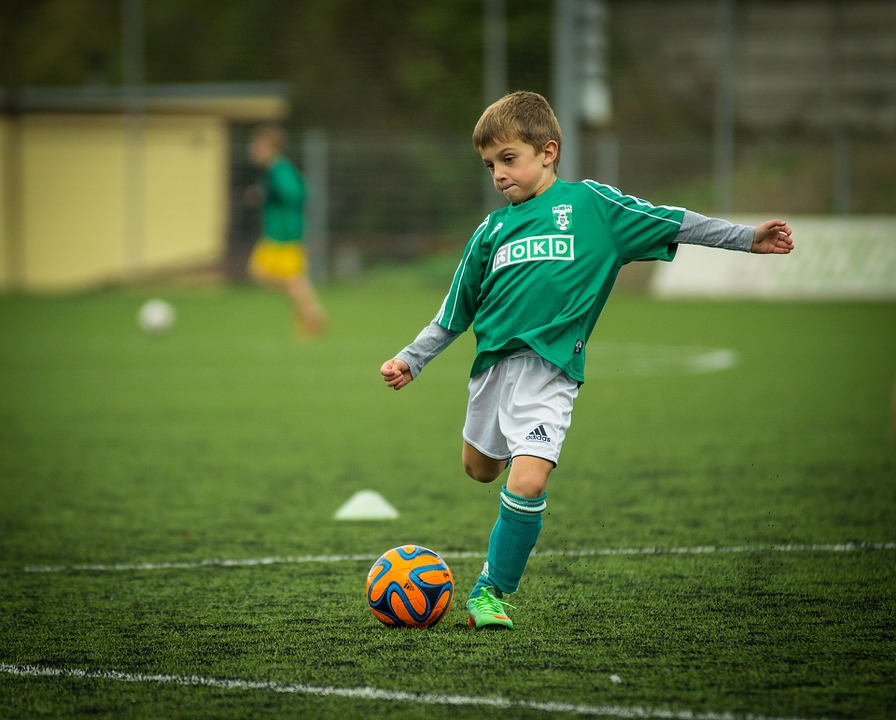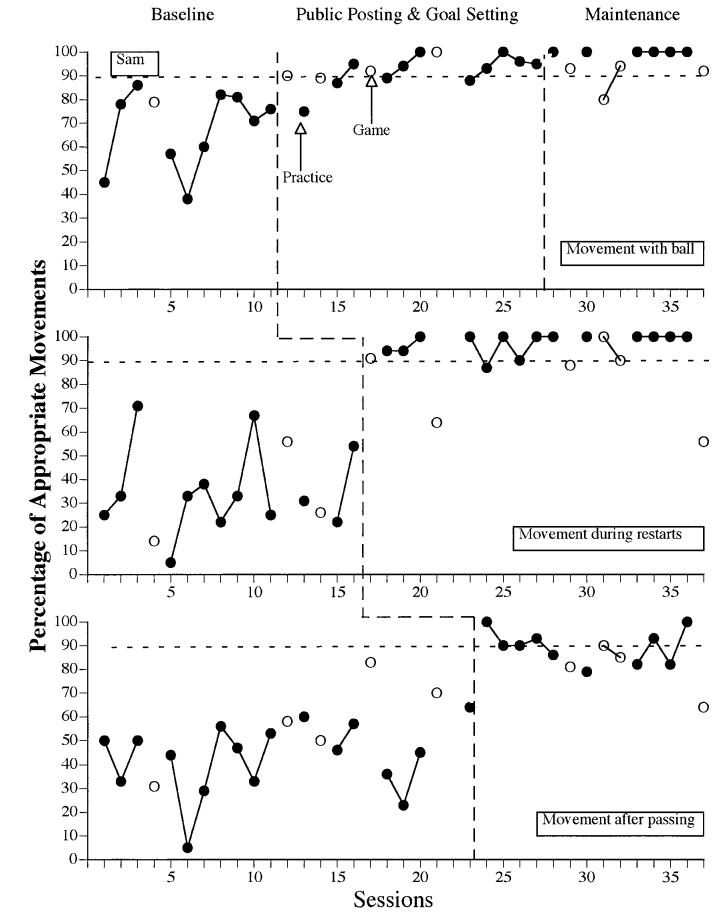Instrumental learning is one of the three ways the brain learns. The other two being imprinting and associative learning. Whereas your brain creates a probabilistic relation between two experiences with associative learning, with instrumental learning your brain creates a probabilistic relationship between your behavior and what your behavior gets you. In football excellent associative learning leads to game intelligence. Excellent instrumental learning leads to technique.
All actions a football player can take are behaviors. When a player has a great technique, this means that through instrumental learning, his brain has created a great probabilistic model that translates the experience of his environment and the control of his body into an action that leads to the ball doing what the player wants the ball to do.
Instrumental learning is based on the ABC-model. In this model A stands for Antecedents. Antecedents is everything that is happening before the action is taken or what is necessary in order to be able to complete the action. If you want a player to score at least he needs to have a ball. Almost all training and coaching is antecedental in the sense that it happens before the players does the actions we want him to take, i.e. when he is playing a real match.
In the ABC-model B stands for Behavior and is simply the action taken by a player.
C stands for Consequences. Consequences is everything that happens after someone has behaved in a certain way. Most people, coaches and trainers are unaware how important the consequences are. Because an overwhelming amount of research has shown that our future behavior is for 80% determined by the consequences of our behavior rather than the antecedents. Antecedents only account for 20% influence on future behavior. Nevertheless, almost all trainers and coaches mainly use antecedents to influence their players. And hence their effectiveness is five times less than it could have been if they also worked with consequences.
Four kinds of consequences
There are four different kinds of consequences that can be ordered according to what you want and what you get as follows:
| Player want: | Player doesn’t want: | |
| Player get: | If your players gets what he wants, it is called positive reinforcement.The frequency of the behavior being reinforced increases, often by a lot. Players feel good about positive reinforcement. | If a player gets what he doesn’t want, it is called punishment. The frequency of behavior that is punished decreases. Unfortunately, that specific behavior is replaced by new undesired behavior as the player gets angry. |
| Player doesn’t get: | If a player doesn’t get what he wants, it is called a penalty. The frequency of the behavior being penalized decreases. Players often feel sad when penalized, but if a player wants attention, then taking that attention away works as a penalty for that player’s brain, but does not result in negative emotions. For that reason ignoring undesired behavior is most often the best way to decrease undesired behavior. | If a player does not get what he doesn’t want, it is called negative reinforcement. Negative reinforcement happens a lot as this consists of threatening someone with punishment or a penalty. With negative reinforcement the frequency of the behavior increases. But only in a limited way. As soon as enough has been done to avoid the negative consequences players stop the behavior. Players feel scared when threatened and relieved when they have avoided the negative consequences. |
If there is too much undesired behavior in a club or a team, then it automatically follows that the undesired behavior is being positively reinforced. If there is not enough desired behavior then it automatically follows that there is not enough positive reinforcement of the players involved. In many cases, once we actually take a look at what the consequences of the desired behavior are, we discover that there are even negative consequences for the desired behavior!
Many clubs think that they have tried positive reinforcement and that it didn’t work for them. But when we look at what has actually been done, we find that these clubs fell for the perception trap. What happened was that rather than ask the players what they actually wanted as a reward, the management or training staff decided top down what a good reward would be. That doesn’t work. One has to check whether the player involved actually experiences the consequence as positive.
As you can see positive reinforcement leads to the strongest increase of desired behavior. Therefore, it is best to use positive reinforcement as much as possible. Nevertheless, for a trainer it is also important to be able to decrease the frequency of undesired behavior using the other three kinds of consequences. The right mix of all four consequences is that you use 80% of the time positive reinforcement and 20% of the time the other three negative consequences. In many clubs this is exactly the other way around: they use negative consequences 80% of the time and only 20% of the time positive consequences. But this limits the ability of players to develop as negative consequences decreases the frequency of behavior or only weakly increases the frequency of behavior. Only positive reinforcement players develop as fast and as unlimited as their talents allow them.
Three different kinds of positive consequences
There are three different kinds of positive consequences:
- Natural consequences. Natural positive consequences are due to the way the world (or reality) works. Natural positive consequences lead to an excellent technique. The way to ball moves and the way the opponent is unable to block the ball and the way the player then scores a goal, are all natural positive consequences that train the brain of the player to become even better.
- Material consequences. These consist of oxygen, water, food and sex. These four are the direct material consequences. There is one indirect material consequence: money. Money is indirect because you can buy the direct material consequences with it. For most people oxygen doesn’t work as a reward because they are saturated with oxygen. But for football players oxygen is actually a good material reward. Because being out of breath during a match works as a negative consequence. Oxygen is a great reward for training intense. Material consequences have a dark side to them. Young football stars get a lot of material consequences, and often for undesired behavior. That is why young players get into problems once they become stars. Earlier only their desired behavior was positively reinforced. But as stars all their behaviors, including undesired behavior, get positively reinforced.
- Social consequences. These are social status like player of the match or most valuable player. The problem with those kinds of social rewards is that they make one player a winner in the team and all the other players losers. So the best social consequences are compliments. Almost everywhere we come compliments are underused. Most people react very well to sincere compliments. So great managers give their players lots of compliments. But it is important to tie your compliment to the exact desired behavior that you want to stimulate. If the brain of the player doesn’t know which behavior led to the compliment then it doesn’t work or can even reinforce undesired behavior. This happens when players give thumbs up for a cross pass that has gone wide. The player receiving the pass wants to reinforce the internal behavior of thinking of him. Yet, he actually reinforces passing wide and increases the frequency of bad passing.
There are two other things that are important to consider when using positive reinforcement:
- Is the consequence certain or uncertain? Certain consequences have way more impact than uncertain consequences.
- Follows the consequence immediately (i.e. within 60 seconds after the behavior) or in the future? Immediate consequences have much more impact than future ones.
“The 5 minutes right after a game is more important than the 5 days leading up to a game.” pic.twitter.com/czT6fpW1jr
— Darian Wilken (@CoachDarian) July 21, 2019
Using instrumental learning in football
Basically whenever a player behaves in a desired way on or off the pitch, someone from the club needs to be there to give a compliment. This means that during practice there needs to be a lot of compliments. Undesired behavior is best ignored. Undesired behavior is different from making mistakes. If a player makes a mistake, he needs feedback so he can avoid the mistake in the future. Feedback is given one on one in a business like manner without emotions. But also without compliments. Many people have learned the sandwich method of giving feedback. The sandwich method works great for the person who has to give the feedback for his task is made easier by mixing the negative message with compliments. Yet, it works really bad for the player as the compliments positively reinforce the undesired behavior that led to the mistakes. If you want to compliment the player for what he did right, wait some time and compliment him for what he did right on a different occasion so his brain understands that the compliments are for the desired behavior instead.
During a match players need to be taught to only compliment each other for desired behavior, i.e. actions that actually led to a positive result for the team. Of course, goals and assists are already celebrated. So that is great. Yet, the team can also celebrate when they win a corner, a free kick or neutralized a dangerous situation. Make sure that the team understand that failed actions are ignored in purpose to prevent the positive reinforcing of undesired behavior.
When substituting a player, not only instruct the player coming on the pitch what to do (which is of course antecedental), but also immediately compliment the player coming off the pitch with a specific behavior of what he did right during the match.
Post match, the manager and the staff need to quickly as possible to compliment players for their actually behaviors. That means not only complimenting the players, but tie the compliment to specific behaviors that the players exhibited on the pitch. As it is hard to remember a specific action for every player, players can be divided between staff members who then compliment the players assigned to them.
Of course when the team has won, the team is happy and elated. Winning is a positive reinforcement all on it’s own. That is why teams start to perform better when they start to win matches. Losing is a negative consequence. Hence losing teams start to do less of desired behavior as that is being punished by a loss. That is why it is so important to teach and train players so they are able to emotionally let go of a loss and to focus on what went well during a lost match. This is helped when the players are actually reminded of the things they did well on the pitch by the staff in the form of a compliment.
Here is a great example of what I mean:
There’s a story about how legendary Dallas Cowboys coach Tom Landry turned around his struggling team. While the other teams were reviewing missed tackles and dropped balls, Landry instead combed through footage of previous games and created for each player a highlight reel of when he had done something easily, naturally, and effectively. Landry reasoned that while the number of wrong ways to do something was infinite, the number of right ways, for any particular player, was not. It was knowable, and the best way to discover it was to look at plays where that person had done it excellently. From now on, he told each team member, “we only replay your winning plays.” (source)
Research into instrumental learning and football
Instrumental learning has been tested in football in the following cases:

